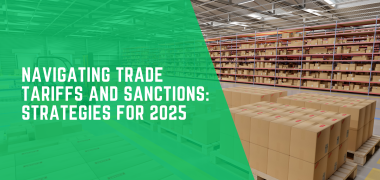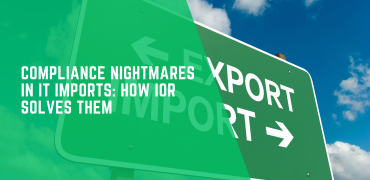Introduction
As global trade dynamics continue to evolve, businesses must adapt to the ever-changing landscape of trade tariffs and sanctions. With 2025 bringing new challenges and opportunities, companies that proactively develop strategies to mitigate risks and leverage market shifts will thrive. This blog post explores the key trends in trade policies, the impact of tariffs and sanctions, and strategic approaches to ensure business resilience and growth.
The Current Trade Landscape
Trade policies are shaped by geopolitical tensions, economic priorities, and regulatory frameworks. In 2025, several factors will influence global trade:
- Geopolitical Conflicts: Tensions between major economies like the U.S. and China, the Russia-Ukraine conflict, and shifting alliances in the Middle East and Asia-Pacific will continue to affect trade relations.
- Regulatory Changes: Governments worldwide are implementing new regulations on imports and exports, particularly in sensitive industries like technology, energy, and defense.
- Supply Chain Disruptions: The aftereffects of the COVID-19 pandemic, coupled with climate change and transportation bottlenecks, still pose challenges for global supply chains.
- Digital Trade and E-Commerce Growth: Digital trade agreements and increased e-commerce regulations are redefining how businesses engage in international trade.
Understanding Tariffs and Sanctions
Trade tariffs and sanctions are key tools used by governments to regulate commerce, enforce policies, and protect domestic industries. Understanding their implications is crucial for businesses.
- Tariffs: These are taxes imposed on imported goods, increasing costs for businesses and consumers. Tariffs can be classified as:
- Ad Valorem Tariffs: Based on a percentage of the product’s value.
- Specific Tariffs: Fixed fees per unit of goods.
- Tariff Rate Quotas: A hybrid model with lower tariffs on imports up to a certain quantity and higher tariffs thereafter.
- Sanctions: These include trade restrictions on specific countries, entities, or individuals, often aimed at enforcing political and economic policies. Sanctions may be:
- Comprehensive Sanctions: A complete ban on trade with a specific country.
- Sectoral Sanctions: Restrictions on particular industries, such as finance, defense, or energy.
- Targeted Sanctions: Measures against specific entities or individuals.
Strategies to Navigate Trade Tariffs and Sanctions
1. Diversifying Supply Chains
To mitigate the impact of tariffs and sanctions, businesses should expand their supplier base and explore alternative markets.
- Establish partnerships with suppliers in tariff-free or lower-tariff regions.
- Utilize free trade agreements (FTAs) to benefit from reduced tariffs.
- Consider nearshoring and reshoring to reduce dependency on high-risk regions.
2. Leveraging Trade Agreements and Preferential Programs
Understanding and utilizing trade agreements can help businesses minimize costs.
- Take advantage of regional trade agreements such as the USMCA, RCEP, or EU FTAs.
- Explore tariff exemptions and duty drawback programs to recover costs.
- Monitor changes in agreements to adjust sourcing and production strategies accordingly.
3. Compliance and Risk Management
Ensuring compliance with international trade laws is essential to avoid penalties and disruptions.
- Implement robust compliance programs to track regulatory changes.
- Conduct due diligence on suppliers and business partners to avoid dealings with sanctioned entities.
- Utilize trade management software to streamline documentation and reporting.
4. Optimizing Pricing and Cost Structures
Managing costs effectively can offset tariff-related expenses.
- Adjust pricing strategies to pass on some costs to consumers while remaining competitive.
- Reconfigure product design and materials to reduce reliance on high-tariff components.
- Utilize bonded warehouses and foreign trade zones to defer duties.
5. Engaging in Advocacy and Policy Dialogues
Businesses can actively participate in trade policy discussions to influence favorable regulations.
- Collaborate with industry associations to advocate for tariff reductions.
- Engage with policymakers to ensure business concerns are considered.
- Stay informed about legislative changes that may impact trade operations.
Case Studies: Adapting to Tariff and Sanction Challenges
Several companies have successfully navigated trade restrictions by implementing strategic measures:
- Apple Inc.: To mitigate the impact of U.S.-China tariffs, Apple diversified its supply chain by increasing production in India and Vietnam.
- Tesla: The company leveraged local manufacturing facilities in China and Europe to avoid import tariffs and reduce costs.
- Pharmaceutical Firms: Many drug manufacturers shifted production and sourcing to regulatory-friendly regions to maintain supply chain continuity.
Future Outlook: Preparing for 2025 and Beyond
As trade policies continue to evolve, businesses must adopt a proactive approach to stay ahead of regulatory changes. Key trends to watch in 2025 include:
- Increased digital trade regulations and cybersecurity measures.
- Strengthened environmental and labor standards in trade agreements.
- Emerging trade alliances that could reshape global supply chains.
Conclusion
Navigating trade tariffs and sanctions in 2025 requires a multifaceted strategy encompassing supply chain diversification, compliance, cost optimization, and advocacy. Businesses that remain agile and informed will be better positioned to overcome challenges and seize new opportunities in the global market. By adopting the right strategies, companies can turn trade barriers into competitive advantages and drive sustainable growth in an increasingly complex trade environment.




